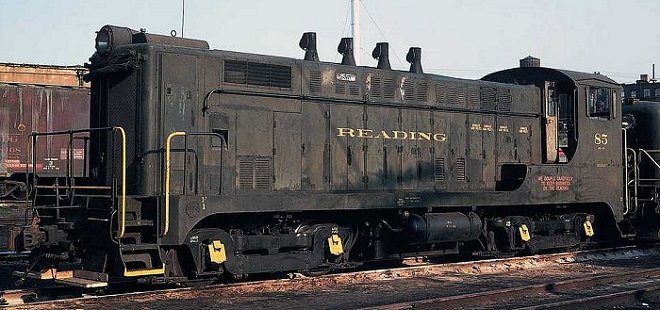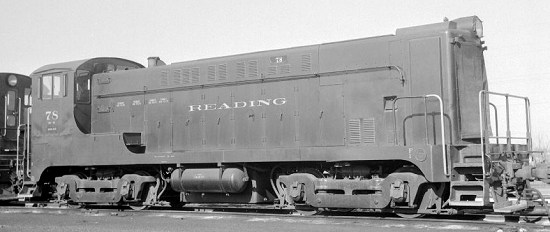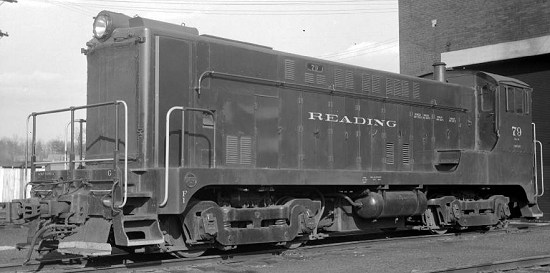Baldwin: VO-1000

Continuing with its dieselization efforts, the Reading purchased a total of 24 Baldwin VO-1000 switching locomotives between 1940 and 1944. These 1000hp units arrived in small groups during this four-year period due to restrictions imposed by the War Production Board. These locomotives were assigned the Reading class OE-10 (NOTE: The first group of DS4-4-1000 locomotives acquired after the war were also included in this class due to their 1000hp rating.), and were numbered #55-59 and #71-89.
 The first two VO-1000s to arrive, #80-81, had a round radiator grille, while the rest of the class had the square grille as shown at left. These locomotives were assigned all over the Reading system, both in the Philadelphia/Main Line area as well as in the coal regions. VO-1000 #79 shown below was assigned to Gordon, as indicated by the "G" stenciled on the pilot. As delivered, the VO-1000s had a single exhaust stack; however, after the war, some units were modified to a four-stack arrangement to improve engine efficiency.
The first two VO-1000s to arrive, #80-81, had a round radiator grille, while the rest of the class had the square grille as shown at left. These locomotives were assigned all over the Reading system, both in the Philadelphia/Main Line area as well as in the coal regions. VO-1000 #79 shown below was assigned to Gordon, as indicated by the "G" stenciled on the pilot. As delivered, the VO-1000s had a single exhaust stack; however, after the war, some units were modified to a four-stack arrangement to improve engine efficiency.
 The Reading's VO-1000s were in service across the system from 1940 through the late 1950s, at which time the railroad began sending them for rebuilding. Many of these locomotives were sent to EMD in 1959 for rebuilding in to the "hybrid" SW-1200ms, while the remainder were rebuilt in 1963 as SW900s and SW1200s. VO-1000 #72 was not rebuilt, it was scrapped outright in 1959. The large number of Baldwins on the system was due in part to the WPB restrictions; however, upon their arrival, the VO-1000s and the later DS4-4-1000s provided many years of reliable service to the Reading.
The Reading's VO-1000s were in service across the system from 1940 through the late 1950s, at which time the railroad began sending them for rebuilding. Many of these locomotives were sent to EMD in 1959 for rebuilding in to the "hybrid" SW-1200ms, while the remainder were rebuilt in 1963 as SW900s and SW1200s. VO-1000 #72 was not rebuilt, it was scrapped outright in 1959. The large number of Baldwins on the system was due in part to the WPB restrictions; however, upon their arrival, the VO-1000s and the later DS4-4-1000s provided many years of reliable service to the Reading.
MODELING NOTES: While the VO-1000s bear a strong external resemblance to the later DS4-4-1000s, there are a few differences to note. The front and rear handrails are squared off. Also, note the curves along the frames at the steps. The frames on the DS4-4-1000s were squared off. The grilles on the VO-1000s have a slight angle to them, while the DS4-4-1000s are flat. Finally, the exhaust stack is located closer to the cab than on the DS4-4-1000s (the turbocharged 700 series). As noted in the text, some of the VO-1000s were converted to a four-stack arrangement, we recommend reference to prototype photos to determine the proper configuration for the unit being modeled. Operationally, these units were in service across the entire system from 1940 through 1959, with most rebuilds coming in 1959 (the remainder in 1963) - since these units were rebuilt into the SW1200ms, it would be inappropriate for VO-1000s and SW1200ms to appear on the layout together.
Did You Know?
Downloads
 A variety of Reading Company operations related documents, etc. that may be of use in your modeling efforts.
A variety of Reading Company operations related documents, etc. that may be of use in your modeling efforts.
 A variety of Reading Company operations paperwork, such as train orders, clearance forms, etc. that will help you operate your Reading layout in a prototypical manner.
A variety of Reading Company operations paperwork, such as train orders, clearance forms, etc. that will help you operate your Reading layout in a prototypical manner.
 Public Timetables, Employe Timetables, and Rulebooks that provide much useful operational information.
Public Timetables, Employe Timetables, and Rulebooks that provide much useful operational information.
 Signs, billboards, and other FREE goodies for your use. We ask only that you help spread the word about The Reading Modeler!
Signs, billboards, and other FREE goodies for your use. We ask only that you help spread the word about The Reading Modeler!

